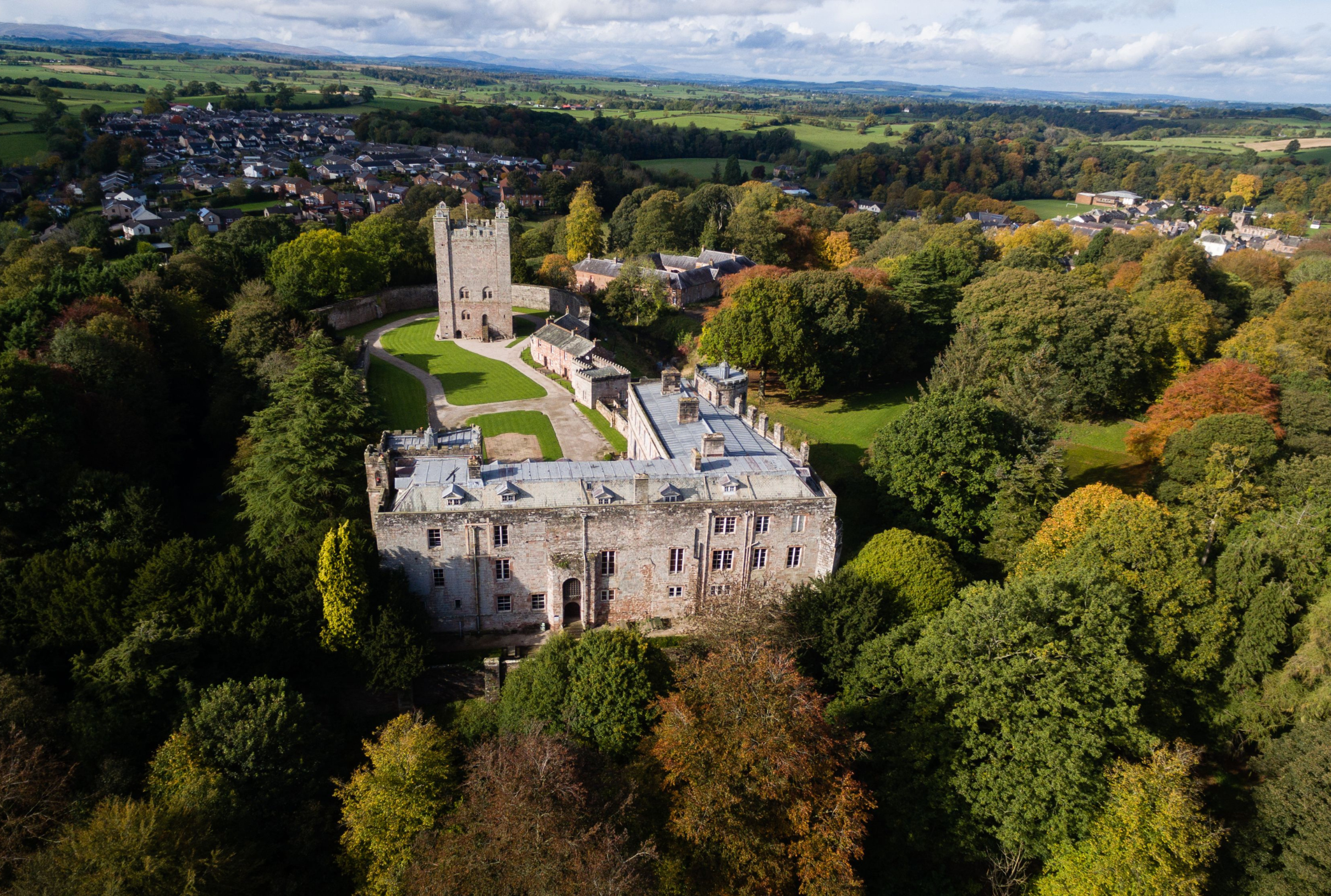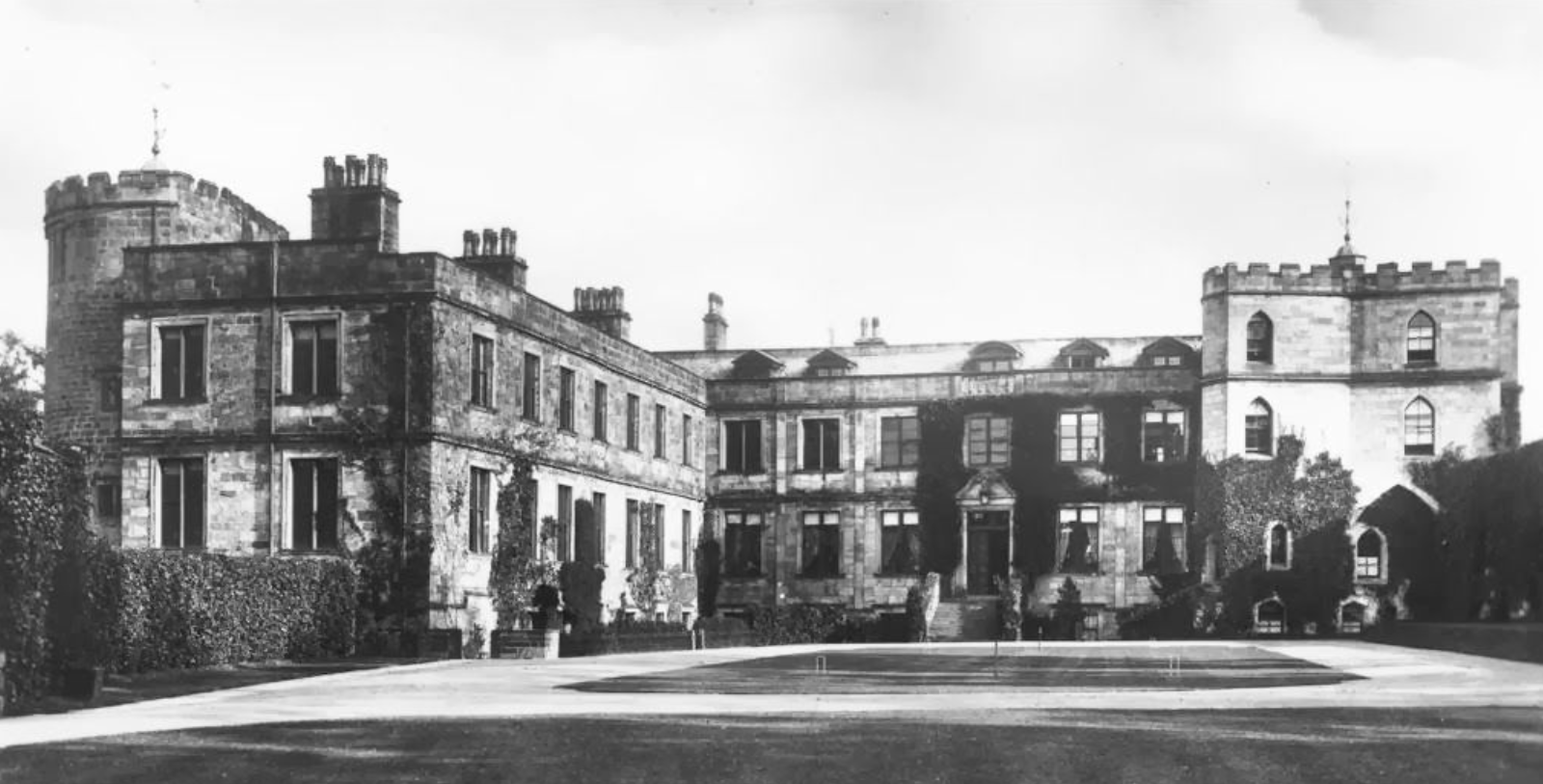Receive for Free - Discover & Explore eNewsletter monthly with advance notice of special offers, packages, and insider savings from 10% - 30% off Best Available Rates at selected hotels.
history
Discover Appleby Castle, a restored Norman fortress that once served as the home for the influential Clifford family.
Appleby Castle, a member of Historic Hotels Worldwide since 2023, dates back to the 12th century.
VIEW TIMELINE
Uncover the History of Appleby Castle
Situated just 15 miles from the English Lake District, this spectacular motte and bailey castle has been held by the Kings of England and Scotland and also boasts one of the few remaining intact Norman keeps.
WATCH NOWIdentified as a Grade I listed building by Heritage England, the historic Appleby Castle has a deeply fascinating story. The complex itself consists of two distinctive structures—an imposing medieval keep and an attending country manor. Contemporary scholars believe the tower debuted at some point in the 12th century, most likely around the year 1170. A feudal lord named Hugh de Montville had originally received the land from King Henry II of England, with whom he enjoyed a close relationship. In fact, Montville was one of the knights that Henry had entrusted to assassinate his main political rival, Archbishop Thomas Beckett. (That particular incident shocked many European nobles and exploded into one of the biggest geopolitical crises of the Middle Ages.) Montville proceeded to create an imposing citadel upon the site, building atop a series of rudimentary embattlements that dated back several decades prior. Composed of durable stone, the new Appleby Castle quickly emerged as the primary place from which Montville and his family ruled over their vast territory, the Barony of Westmorland. But Montville did not get to experience his new keep for very long. Indeed, the ambitious aristocrat joined an ill-fated rebellion to overthrow King Henry II just a few years later. The King confiscated the facility in consequence and granted it to another trusted lieutenant, Ranulph de Glanville, Sheriff of Yorkshire. Glanville then renovated the compound, building tall curtain walls and a corresponding “Great Hall.”
In 1203, King John I of England decided to give the castle to Robert de Vipont, a nephew of the late Hugh de Montville. The Viponts then lived at Appleby Castle until Roger Clifford became its principal owner through marriage during the mid-13th century. The Clifford family would subsequently count the location among their estates over the next 400 years. (The castles that the Clifford family presided over included Brough Castle, Brougham Castle, Pendragon Castle, Skipton Castle, and of course, Appleby Castle.) They went about expanding the size of Appleby Castle, especially once the structure emerged as an integral defensive barrier against periodic Scottish raiding parties from the north. Among the most significant architectural developments to occur under the Cliffords were the renovations done to the kitchens, chamber apartments, and Great Hall. One of the most influential members of the Clifford family to watch over Appleby Castle was Lady Anne Clifford, who inherited the complex in the 17th century. She oversaw many momentous changes to affect the castle, notably constructing an even greater series of fortifications. However, those defenses failed to protect the facility during the English Civil War, as a detachment of the Parliamentarian New Model Army successfully besieged Appleby Castle in 1648. But Lady Anne managed to reobtain all her beloved estates following the cessation of hostilities and looked after Appleby Castle for the rest of her life.
In the wake of Lady Anne’s death in 1676, Appleby Castle passed onto her heirs, the Earls of Thanet. They immediately set about reconstructing the complex to resemble a breathtaking palace. Their diligent efforts were best epitomized by the work done to the Great Hall, which they turned into a spectacular mansion that showcased some of the finest artistic philosophies of the Renaissance. The structure continued to function as a private manor for many generations thereafter, with distant descendants of the family renovating it well into the height of the Victorian era. Nevertheless, Appleby Castle was eventually sold to Denis Vernon—the entrepreneurial CEO of Ferguson Industrial Holdings—during the late 20th century. Establishing the historic castle complex as his own residence, Vernon invested heavily in safeguarding its architectural integrity. Then in the 1990s, new owners obtained Appleby Castle. Adopting Vernon’s mission to preserve the castle grounds, they began investigating ways to open the compound to the public. Perhaps their most ambitious plan involved transforming a portion of the mansion into a boutique hotel, which current owner Sally Nightingale finished in 2013. Today, Sally Nightingale proudly remains the sole proprietor of Appleby Castle and cherishes her role as the first independent female owner of the facility since Lady Anne Clifford. Thanks to her masterful guidance and utmost care, the location remains one of the most celebrated destinations in Northern England.
-
About the Location +
Appleby-in-Westmorland is one of the quaint market towns that dot the pastoral landscape of Northern England’s beautiful Cumbria region. Sharing a border with Scotland, Cumbria itself has a fascinating history that harkens back millennia. Indeed, archeological evidence has revealed the presence of human activity since the Neolithic period, with several sites featuring equipment utilized to mass produce widely used stone axes. Many regional prehistoric settlements also featured various religious structures common to the era, like stone circles and henges. (Perhaps the most noteworthy ancient monument still standing in Cumbria now is the Castlerigg Stone Circle outside of Keswick.) Celtic cultural groups eventually formed throughout the region amid the subsequent Bronze and Iron Ages. Among the most predominant Celtic tribes were the Carvetii and Brigantes, who created numerous villages across Cumbria. Those Celtic peoples managed to remain independent of foreign influence for generations, even as the Roman Empire began invading Great Britain further south during the 1st century A.D. In fact, the native population briefly cooperated with the newly arrived Roman magistrates before distancing themselves several years later. Coming to view the nominal Celtic autonomy as a threat, Rome sent two legions to depose the local rulers and officially integrate Cumbria into the province of Britannia.
To safeguard the area from other potentially hostile Celts, the Roman Emperor Hadrian ordered a line of imposing fortifications constructed along Cumbria’s northern border. Known as “Hadrian’s Wall,” a permanent garrison of some 10,000 auxiliary soldiers manned the interconnected citadels for decades. The Romans also settled across Cumbria, too, establishing their own towns and implementing their own legal codes. The native Cumbrians subsequently adopted those customs as well, forming the basis for future forms of government once the Roman Empire collapsed during the 5th century. In the ensuing power vacuum, bands of Cumbrian nobles created a multitude of petty fiefdoms that gradually coalesced into the Kingdom of Rheged. However, neighboring feudal societies eventually conquered the area, starting first with the Kingdom of Strathclyde and then the Kingdom of Northumbria. By the time William the Conqueror had seized the English throne in the 11th century, the site of modern-day Cumbria had fallen under the jurisdiction of the Kingdom of Scotland. But in 1092, William’s son, King William II of England, directed a military campaign that seized Cumbria permanently from the Scots. Cumbria thus became a battleground between England and Scotland over the next five centuries, with the regional capital of Carlisle enduring a number of major sieges.
While the tension subsided following the personal union of both countries in the early 17th century, Cumbria nonetheless still experienced a few pitched battles related to the English Civil War and the Jacobite Risings. Peace and stability arrived in the wake of those conflicts though, which provided a ripe atmosphere for extensive industrialization to take place in Cumbria’s urban localities during the 19th century. Communities like Workington and Kendal emerged as major factory towns, while Barrow-in-Furness became home to a bustling shipyard. Even Carlisle saw countless steel mills and iron refineries debut in great quantities. Nevertheless, most of Cumbria remained rural in character, presenting a rich bucolic charm that artists and writers alike adored to experience. Notable English writers—such as William Wordsworth and Samuel Taylor Coolidge—often used the Cumbrian geography to inspire their own uniquely creative works. The fascination with Cumbria’s enduring natural beauty continued well into the 20th century, helping to spawn a conservation movement that preserved several hundred acres as the “Lake District National Park.” A designated UNESCO World Heritage Site, the wonderful Lake District National Park is now visited by nearly 16 million people every year. (Hadrian’s Wall is another UNESCO World Heritage Site that cultural heritage travelers can discover when out exploring Cumbria’s extensive past.)
-
About the Architecture +
While the historic Appleby Castle displays many unique architectural styles, the most prominent are the original Norman aesthetics that first appeared during England’s medieval period. Nowhere are the Norman design aesthetics more apparent on-site than at the castle keep, known today as “Caesar’s Tower.” (The historic structure currently serves as the home to The Norman Centre, a fascinating museum dedicated to chronicling the rich Norman heritage of the area.) The Normans themselves were an enterprising cultural group of Norse origin that hailed from Northern France. Prominent warriors, they conquered significant swathes of European territory throughout the Middle Ages. In fact, the Normans had even managed to successfully invade the island of Sicily in the mid-11th century. When the Normans finally arrived in England in 1066, they subsequently brought their language, technology, and art with them. Perhaps one of the most enduring artistic forms that appeared in England under Norman rule was architecture. Building prominent military and religious structures, Norman architecture redefined the English landscape for centuries.
Among the most noteworthy edifices developed was the Norman motte-and-bailey castle compound. The sites were actually composed of two substructures—an artificial mound called a “motte” and a fortified enclosure referred to as a “bailey.” Atop the motte would sit a towering keep, which the Norman lords constructed out of wood and, later, stone. The keeps featured a blend of magnificent Norman-inspired design motifs, such as chevron patterns and cylindrical pillars. (This was particularly true for stone keeps.) However, the most striking architectural feature of Norman-era keeps was the grand “Norman arch.” Common in most Norman structures, the arches were massive, as well as incredibly beautiful. Some arches even possessed an intricate construct known as a “tympanum,” a geometric platform sitting over the arch that showcased gorgeous illustrations. Nevertheless, the Norman architecture of medieval England eventually ingrained itself within English culture, inspiring generations of future English architects to incorporate it into their own designs. Norman architecture today is typically considered to be a part of the larger Romanesque architectural style that affected Europe throughout much of the 11th and 12th centuries.
-
Famous Historic Events +
Baron de Clifford (1299 – 1676): One of England’s most prominent peerages, the Baron de Clifford was originally held by the Clifford family. The lands assigned to the title were massive, including fiefdoms in Herefordshire, Yorkshire, and Westmorland (Appleby Castle). King Edward I had created the rank exclusively for Robert de Clifford in 1299. An English soldier of Norman ancestry, Robert had helped defend Northern England in the Wars of Scottish Independence. Robert had specifically fought on behalf of King Edward I during the battles of Falkirk and Caerlaverock Castle, before dying amid a Scottish cavalry charge at Bannockburn in 1314. However, Robert’s heir, Roger Clifford, had nearly destroyed the Baron de Clifford in the wake of his father’s death. Seeing King Edward II as a weak successor, Roger and other lords joined an aristocrat named Roger Mortimer in his attempt to forcibly curtail royal authority. Furthermore, Mortier and his allies had wished to remove the influential Despenser family from the King’s court. The uprising proved successful at first, with Mortimer forcing a brief exile of the Despensers in 1321. King Edward II nonetheless managed to rally more nobles to his cause, resulting in the defeat of the rebels at the battles of Bridgnorth and Boroughbridge a year later. Roger himself was then executed alongside 40 other lords and his titles were confiscated.
Upon the final deposition of King Edward II in 1327, Roger’s brother managed to get Baron de Clifford formally reinstated. Despite the political controversy, the Clifford family continued to rise in power. For instance, John Clifford, the 7th Baron of Clifford, served alongside King Henry V in the Hundred Years’ War. A respected jouster, John aided the King in his pivotal sieges of Harfleur and Cherbourg in France. Perhaps John’s greatest contribution was his presence at the legendary Battle of Agincourt in 1415, which saw a numerically inferior English army famously rout a highly sophisticated French force. Thomas Clifford, 8th Baron de Clifford, continued to back the crown when a rival branch of the royal household, the Yorkists, challenged the claim of King Henry VI, thus starting the Wars of the Roses. The Cliffords were principal allies of the King and formed an important part of his coalition, the Lancastrians. Thomas Clifford even served as a major general, ultimately perishing at the First Battle of St. Albans in 1455. Thomas’ own son—John Clifford, 9th Baron de Clifford—continued to diligently support the Lancastrians, too. He notably fought with distinction at the Battle of Wakefield in 1460, where he slew the original Yorkist claimant, Richard of York, as well as one of his children, Edmund, Earl of Rutland.
The Baron would meet his own demise at the Battle of Towton not long thereafter, which saw the new Yorkist challenger, Edward, become King Edward IV. In retribution, the King revoked the Clifford family’s estates. (Appleby Castle itself fell into the temporary ownership of Sir John Parr, Lord of Kendal.) Indeed, they failed to earn their castles back once King Edward IV was succeeded by his brother, Richard, Duke of Gloucester, during the late 15th century. But fortune finally returned to the Cliffords once King Richard III was killed at the Battle of Bosworth Field by the forces of Henry Tudor, a distant relative to the former King Henry VI. Now crowned as King Henry VII, Henry Tudor restored the Baron de Clifford and its many attending lands to the Clifford family in 1485. The Cliffords subsequently reemerged as influential courtiers in English society over the following decades. The 11th Baron of Clifford—Henry Clifford—even earned an additional title, the Earldom of Cumberland, in the 16th century. However, the family line had grown thin around the middle of the 17th century, with Lady Anne Clifford surviving as the final head of the household until her own death in 1676. The title Baron de Clifford eventually passed onto her eldest daughter’s in-laws, the Tufton family. Also known as the Earls of Thanet, the Tufton family would then possess the title for the next several generations.
-
Women in History +
Lady Anne Clifford: Officially the Countess of Dorset, Pembroke, and Montgomery, 14th Baroness de Clifford, Lady Anne Clifford was the last head of the powerful Clifford family. Indeed, the Cliffords played significant roles in major events throughout English history, like the Hundred Years’ War and the Wars of the Roses. Their accomplishments led to great affluence, as best epitomized by the five castles the family controlled at the time of Lady Anne’s birth in the late 16th century. Lady Anne herself was the daughter of George Clifford, a renowned naval officer who had a considerable reputation within the Tudor court. As a child of the nobility, Lady Anne received access to the finest education and developed a lifelong passion for the arts. In fact, her primary teacher had been the celebrated poet, Samuel Daniel. However, a strong confidence complimented her studious demeanor, earning the young girl many admirers during her youth. Lady Anne’s poise even won her the praise of another inspiring woman, Queen Elizabeth I of England.
Lady Anne would benefit greatly from such an attitude, especially once her father disinherited her in favor of a male heir—his brother, Francis Clifford. The move had been a controversial one, as the Clifford family had operated under the practice of absolute cognatic primogeniture since the 14th century. (For reference, absolute cognatic primogeniture legally mandated that any inheritance go to the surviving firstborn child, regardless of gender.) Lady Anne spent decades fighting in court to restore her rights to the family's numerous estates in the wake of George’s death in 1617. Despite the legitimacy of her claims, she nonetheless received tepid support from many men, including her first husband, Sir Richard Sackville, 3rd Earl of Dorset. King James VI and I (of Scotland, England, and Ireland) also gave little assistance, offering a weak settlement that did little to uphold her status as the rightful heir. But Lady Anne only continued to endure in the face of overwhelming odds. Her dogged resistance heartened numerous women, too, such as the King’s own wife, Anne of Denmark.
Having spent many years fighting for her rights, Lady Anny finally became the legal heir upon the death of her cousin, Henry Clifford, in 1643. She subsequently commissioned a brilliant mural of her family known as The Great Picture in honor of the moment. Over the next three decades, Lady Anne would act as a wonderful steward for all five castles. She diligently restored every estate and even initiated a second round of renovations to the ones that were assaulted during the English Civil War. (Lady Anne was a devout royalist during the conflict, which endeared her closely to King James II after the monarchy was restored in the 1660s.) Lady Anne’s time as the head of the Clifford family also saw her pursue many charitable endeavors, such as the restoration of several churches in the towns outside of her estates. She was even an important patron of the arts and pursued some writing of her own in her spare time. In the end, Lady Anne Clifford passed away at the impressive age of 86 in 1676, leaving behind a legacy that has continued to fascinate countless people ever since.

























